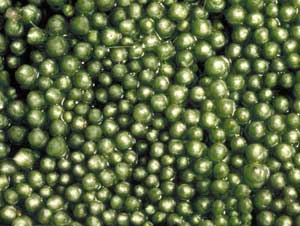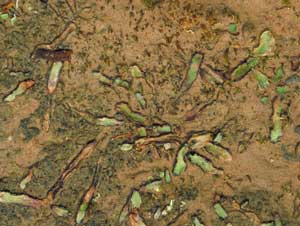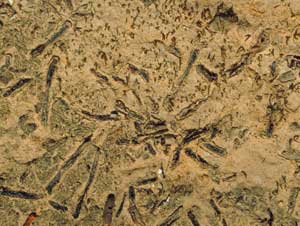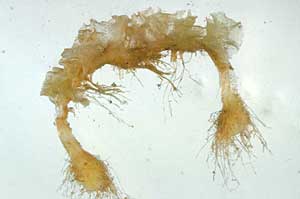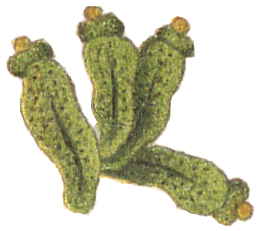
Ecology - Habitats
Bryophytes in arid areas
Many people are surprised to hear of bryophytes in arid areas. Surely such delicate plants couldn't possibly survive in such harsh, dry environments! Arid environments certainly present considerable challenges but are home to many bryophytes. Sure, take a rainforest bryophyte into a desert and it won't be able to survive. Is that really surprising? Take a rainforest vascular plant into a desert and it won't survive either![]() .
.
In hot, dry areas water is typically scarce, with rainfall unpredictable, and the bryophytes living there adopt various survival strategies. One is to grow in the more protected MICRO-HABITATS – such as at the bases of grass tussocks, on tree trunks, under boulder overhangs and in rock crevices, to give just a few examples. Consider the benefits provided by a tree trunk. A bryophyte growing on the predominantly shady side of a tree trunk will of course be protected from the full force of the sun. Additionally, the tree trunk concentrates some of the rain falling on the tree. During rainfall, some rain will fall directly on the trunk, some on the branches above, with some falling on the branches flowing down onto the trunk, so adding to the amount of water the trunk is exposed to. The benefits are greatly increased if the bark is rough and fissured. Such bark provides a much greater surface area (with numerous shaded micro-habitats) and slows down the flow of water, as well as providing numerous spots where a few droplets can be trapped, allowing any nearby bryophytes to benefit from the water over a longer period. Now turn your thoughts to a large boulder that is half buried in the soil in an otherwise barren area. During rain there will be runoff from the boulder. The soil around the base of the boulder gets water directly from the rain as well as the runoff. In a torrential downpour the contribution of the runoff may be irrelevant. But during light rain the runoff is likely to ensure that the soil near the base of the boulder stays wetter for longer than the soil further away from the boulder. The advantages created by trees, boulders or tussocks may be slight but, for some species, enough to create a tolerable habitat or sufficient to prolong benign conditions long enough to allow spore production.
Of course, you do also find arid area bryophytes growing in the open, but even here there are different microhabitats. For example, in the Southern Hemisphere a north-facing slope would undergo more heating than a south-facing slope, and vice-versa in the Northern Hemisphere. While some species would be able to tolerate either aspect, others would survive only on the more benign slope.
Arid area bryophytes open up and actively photosynthesize when there is moisture available, but close up and become dormant when conditions become too hot and dry. Bryophytes are much more resistant to heat when dry than they are when moist. Experiments have shown that species which can tolerate temperatures of 80-100°C (or even more) when dry, die at temperatures of 40-50°C if they are kept moist.
It's a fact of physics that close to the ground the air is very slowly moving. This boundary layer is a result of the friction between moving air and the ground. It's well known that still or very slowly moving air is a good insulator and it is also the case that molecules (for example, water vapour) move slowly through the boundary layer, since diffusion rather than convection is the moving force. Thus water, evaporating from the ground, is retained for a while within the boundary layer and creates a slightly more humid micro-climate. Arid area bryophytes growing on the ground are typically low growing and within that somewhat protective boundary layer. There's more in the BOUNDARY LAYERS CASE STUDY![]() .
.
Many exposed mosses grow as dense carpets or small hummocks, each a colony of numerous plants. On the right is a close-up view of the top of a colony of Bryum argenteum. Each of those bumps is the top of a separate plant. Here ![]() is a side-on view of part of the same colony. In such dense colonies water is lost more slowly than in sparser growths. For one thing, the upper parts of such carpets or hummocks shade the lower parts and so slow down the loss of water from within the colony. Additionally, dense carpets or hummocks expand the boundary layer. Any roughened surface (such as the surface of a dense moss colony) that increases friction with the air will slow air movement and so modify the boundary layer. In effect, a moss carpet or hummock raises the boundary layer over itself.
is a side-on view of part of the same colony. In such dense colonies water is lost more slowly than in sparser growths. For one thing, the upper parts of such carpets or hummocks shade the lower parts and so slow down the loss of water from within the colony. Additionally, dense carpets or hummocks expand the boundary layer. Any roughened surface (such as the surface of a dense moss colony) that increases friction with the air will slow air movement and so modify the boundary layer. In effect, a moss carpet or hummock raises the boundary layer over itself.
Carpets or hummocks are a feature of the community as a whole. The separate gametophytes also have various structural features that help maximise the use of any available moisture. When mosses dry out there are various ways in which they close up. In some the leaves bend inwards at the base, finishing up flat against the stem. In others they curl up around the stem. In dry plants there are numerous very narrow gaps between neighbouring leaves or between leaves and stems that are ideal conduits of tiny amounts of water by capillary action. When water (even early morning dew) becomes available these channels help move it quickly throughout the plant. The leaves of many arid area mosses have papillae. A papilla is a tiny protrusion on the cell surface. It may be just a simple bump or it may be split or forked in some way. In a densely papillose leaf the gaps between the papillae provide numerous channels for rapid water movement by capillary action and so help spread, and thereby maximise the use of, tiny amounts of water. At the same time the tips of the papillae are likely to remain above the watery film and so provide places where the gas exchange necessary for photosynthesis can take place. As an aside it's worth noting that papillae are not confined to arid area species, are also found in many of the leafy liverwort genera and are not always associated with capillary flow. For capillary flow the papillae need to be packed densely enough to create fine channels between the papillae and papilla shape may also be important. Studies have also shown that the tips of the papillae in various species are water repellent, thereby keeping them dry and available as sites for gas exchange. Many mosses of dry areas have slightly rolled up leaf margins. This creates a very narrow and somewhat tubular channel along the length of each leaf margin, Such channels also provide routes for capillary movement.
The following drawing, by Judith Curnow, is of the moss Triquetrella papillata ![]() and shows part of a leaf surface in profile. You can see protruding papillae of various shapes. The black scale bar represents a length of 20 micrometres. Click on the drawing for another one showing the papillae of this moss.
and shows part of a leaf surface in profile. You can see protruding papillae of various shapes. The black scale bar represents a length of 20 micrometres. Click on the drawing for another one showing the papillae of this moss.
 scale = 20 µm (click to enlarge)
scale = 20 µm (click to enlarge)
The moss family Pottiaceae has numerous genera and species, many of which are very common in harsh, exposed areas and are renowned for papillose leaves and curved leaf margins. To give you a rough idea of the prevalence of this family in dry areas, consider the book, by David Catcheside, given in the next reference button. It is a technical book with detailed descriptions of the mosses found in South Australia, predominantly a very dry state. The book deals with 31 families and has 184 pages of species' descriptions and 84 of those pages are devoted to the family Pottiaceae. The next largest family (with 36 pages) is the Bryaceae. Of course, there have been changes in taxonomy and additional discoveries since the book was published in 1980, but the relativities suggested by those page counts would still be much the same today![]() .
.
The leaves of many arid area mosses have white hairpoints at their tips. When the leaves of Campylopus introflexus are closed up they are hard to see but the hairpoints show very well ![]() . Here
. Here ![]() is the species Tortula princeps (a member of the family Pottiaceae) with the plants moist and the leaves showing very clearly – but you can also see the hairpoints quite easily. Hairpoints have more than one role. Hot, arid areas often become quite cool overnight. Cold nights may result in early morning dew or at least a relatively high night-time or early morning atmospheric humidity, especially near ground level. The multitude of hair points in a moss colony provide numerous condensation points, which give the colony a very effective means of gathering water. Those numerous hairpoints are also a source of friction between the moss layer and the passing air. Friction slows the airflow so the hairpoints help thicken the boundary layer. Another feature of those hairpoints is that they help protect the colony against overheating by reflecting some of the incident radiation. Experimental studies on mosses, comparing plants with hair points with those where the hairpoints have been removed, have shown that hairpoints can reduce water loss by about a third.
is the species Tortula princeps (a member of the family Pottiaceae) with the plants moist and the leaves showing very clearly – but you can also see the hairpoints quite easily. Hairpoints have more than one role. Hot, arid areas often become quite cool overnight. Cold nights may result in early morning dew or at least a relatively high night-time or early morning atmospheric humidity, especially near ground level. The multitude of hair points in a moss colony provide numerous condensation points, which give the colony a very effective means of gathering water. Those numerous hairpoints are also a source of friction between the moss layer and the passing air. Friction slows the airflow so the hairpoints help thicken the boundary layer. Another feature of those hairpoints is that they help protect the colony against overheating by reflecting some of the incident radiation. Experimental studies on mosses, comparing plants with hair points with those where the hairpoints have been removed, have shown that hairpoints can reduce water loss by about a third.
Leafy liverworts show little variation with changes in atmospheric moisture but few leafy liverworts are found in dry areas, especially in the open exposed areas in which you may still find many moss species. In dry areas you'd look for leafy liverworts in the more sheltered microhabitats.
In contrast to the leafy liverworts several genera of thallose liverworts are common in hot, dry areas.
The photos above show the thallose liverwort Asterella drummondii with strap-like thalli. The species is often found well out in the open. When wet the thalli are open and green. Under much drier conditions that same colony takes on this appearance in the photo on the right. Now the thalli have rolled inwards, along their length, so that only fairly thin, black lines now show where previously there were green straps. On the underside of each strap there are blackish scales that act as a protective covering for the inrolled thallus. In the second photo the thalli have closed and all you see are the scales, which protect the thallus. Targionia hypohylla is another thallose liverwort found in fairly dry areas, though often in slightly protected micro-habitats. Many Riccia species are found in dry areas. The thalli are Y-shaped, the exact proportions (long and narrow, short and squat) varying between species. They are commonly found on damp soil in seasonally wet areas and this photo ![]() shows a colony of Riccia multifida in such a habitat. In this photo
shows a colony of Riccia multifida in such a habitat. In this photo ![]() you can see a bryologist collecting specimens of Riccia. The habitat is the bare soil of a small dam in a forest in central New South Wales. The area is hot and dry for at least several months each year but in many years there is likely to be enough rain to raise the water level in this dam considerably. During the hotter months, as water evaporates from the dam, the water level will drop, leaving a temporary band of damp soil around the receding water's edge. It is in such a damp band that this bryologist is searching, for it is there that you may find Riccia thalli in various stages of development. You can see the slightly darker band of damp soil in the photo. The thalli of Riccia also fold up along their long axes. Here we see Riccia lamellosa open
you can see a bryologist collecting specimens of Riccia. The habitat is the bare soil of a small dam in a forest in central New South Wales. The area is hot and dry for at least several months each year but in many years there is likely to be enough rain to raise the water level in this dam considerably. During the hotter months, as water evaporates from the dam, the water level will drop, leaving a temporary band of damp soil around the receding water's edge. It is in such a damp band that this bryologist is searching, for it is there that you may find Riccia thalli in various stages of development. You can see the slightly darker band of damp soil in the photo. The thalli of Riccia also fold up along their long axes. Here we see Riccia lamellosa open ![]() and closed
and closed ![]() . The black scales on the underside of a closed-up Riccia limbata
. The black scales on the underside of a closed-up Riccia limbata ![]() are even more striking. However, not all Riccia species have black scales. Riccia crinita has white hairs, as you can see in this photo
are even more striking. However, not all Riccia species have black scales. Riccia crinita has white hairs, as you can see in this photo ![]() . When closed, the hairs provide a protective layer. and also a means of trapping moisture.
. When closed, the hairs provide a protective layer. and also a means of trapping moisture.
A number of typically arid area bryophytes are individually short-lived, but persistent as a species, in a given area. In these bryophytes the gametophytes, typically small, develop quickly from spores, produce sporophytes and large spores and then die. A number of Riccia species fall into this category and examples amongst the mosses are the genera Acaulon and Ephemerum. The spores are often quite large, at times over a tenth of a millimetre in diameter, and incapable of long-distance dispersal. Such species are commonly described as annual shuttle species. Like the annual vascular plants (especially of the daisy family) that are common in dry habitats, the annual shuttle species do not tolerate drought but evade it by the production of drought-resistant sexual propagules. Because the large spores tend to move only very short distances, the annual shuttle species tend to persist in a given area for many years – not as individuals but as a species. The gametophytes of annual shuttle species tend to appear after rain in micro-habitats that are ephemeral but which tend to re-occur with some degree of regularity. An example of this is the damp soil around the forest dam shown in a photo a little earlier. At the other extreme are the perennial stayers, with far more robust gametophytes and with various adaptations to ensure long term survival as individuals. In arid areas the perennial stayers are best represented by the desiccation-resistant mosses but there are perennial liverworts as well. For example, with the genus Riccia there are perennial stayers as well as annual species. There's a more detailed description of the various strategies in the LIFE-HISTORY STRATEGIES CASE STUDY.
Fossombronia is a genus of seemingly delicate thallose liverworts and a number of Fossombronia species are found in hot, dry regions. This photo ![]() shows some Fossombronia plants growing in a recently wet Australian arid area. You can see a number of black spore capsules, each atop a translucent stalk. You can also see that parts of the gametophytes are white. They are beginning to die. Here's another photo
shows some Fossombronia plants growing in a recently wet Australian arid area. You can see a number of black spore capsules, each atop a translucent stalk. You can also see that parts of the gametophytes are white. They are beginning to die. Here's another photo ![]() showing a large number of white, dead Fossombronia gametophytes. Rapid spore production after a rainy period is one way in which a Fossombronia can perpetuate its species in an area. Fossombronia gametophytes, as they begin to dry out also produce tubers. The accompanying photograph shows such tubers. The plant in the photograph has been removed from the soil. When it was growing, all you would have seen above the ground was the long axis of the gametophyte with its flimsy, almost leaf-like outgrowths. The ends of the axis had turned down and produced swollen tubers beneath the ground. Eventually the above-ground gametophyte would die, leaving just the tubers within the soil. These tubers stay dormant in the soil until suitable rains come again, upon which the tubers produce fresh lettuce-like gametophytes.
showing a large number of white, dead Fossombronia gametophytes. Rapid spore production after a rainy period is one way in which a Fossombronia can perpetuate its species in an area. Fossombronia gametophytes, as they begin to dry out also produce tubers. The accompanying photograph shows such tubers. The plant in the photograph has been removed from the soil. When it was growing, all you would have seen above the ground was the long axis of the gametophyte with its flimsy, almost leaf-like outgrowths. The ends of the axis had turned down and produced swollen tubers beneath the ground. Eventually the above-ground gametophyte would die, leaving just the tubers within the soil. These tubers stay dormant in the soil until suitable rains come again, upon which the tubers produce fresh lettuce-like gametophytes.
Up the alps and near the poles
While many people will think of deserts when the word "arid" is mentioned the alps and the polar regions can also be considered arid. In very cold areas desiccation can be as great a problem as it is in arid areas. For example, in the polar regions water is abundant in principle, but much is locked away as ice, with free water being quite scarce in many places an it is free water that living organisms need. In all such areas strong, drying winds are another form of stress. Not surprisingly, you will also find polar bryophytes adopting many of the strategies outlined above.
Experiments have shown that many drought-tolerant bryophytes also tolerate freezing, if the freezing happens slowly. That is usually the case in natural conditions, with water slowly removed from the cells so that freezing leads to the formation of extra-cellular, rather than intra-cellular, ice crystals. Since water expands when it freezes, there is a danger that water within bryophyte cells would freeze and so burst the cells. Temperate and desert areas can experience freezing temperatures but clearly freezing is a much more common danger in very cold areas, such as polar and alpine regions.
At very high latitudes bryophytes are subject to very lengthy, even continuous light during the summer months. Experiments have shown that continuous illumination can cause some chloroplast disruption and so reduce photosynthetic activity. Continuous light is one stress that is clearly peculiar to the near-polar regions, the temperate and tropical parts of the world having distinct nights and days throughout the year.
On the subject of polar bryophytes and their adaptations, the bryologist RE Longton has noted that
None of these features, except perhaps tolerance of continuous light, can be regarded as a specific adaptation to polar conditions since all are shown by mosses growing in apparently more favourable environments ... The success of bryophytes in polar environments thus appears to derive from attributes that are widely represented among mosses (sic) in general rather than from specific adaptations to polar conditions.
Longton also noted that most polar bryophytes are perennial stayers![]() .
.
![An Australian Government Initiative [logo]](/images/austgovt_brown_90px.gif)


